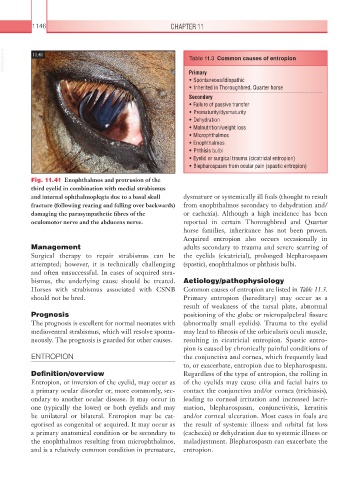Page 1171 - Equine Clinical Medicine, Surgery and Reproduction, 2nd Edition
P. 1171
1146 CHAPTER 11
VetBooks.ir 11.41 Table 11.3 Common causes of entropion
Primary
• Spontaneous/idiopathic
• Inherited in Thoroughbred, Quarter horse
Secondary
• Failure of passive transfer
• Prematurity/dysmaturity
• Dehydration
• Malnutrition/weight loss
• Microphthalmos
• Enophthalmos
• Phthisis bulbi
• Eyelid or surgical trauma (cicatricial entropion)
• Blepharospasm from ocular pain (spastic entropion)
Fig. 11.41 Enophthalmos and protrusion of the
third eyelid in combination with medial strabismus
and internal ophthalmoplegia due to a basal skull dysmature or systemically ill foals (thought to result
fracture (following rearing and falling over backwards) from enophthalmos secondary to dehydration and/
damaging the parasympathetic fibres of the or cachexia). Although a high incidence has been
oculomotor nerve and the abducens nerve. reported in certain Thoroughbred and Quarter
horse families, inheritance has not been proven.
Acquired entropion also occurs occasionally in
Management adults secondary to trauma and severe scarring of
Surgical therapy to repair strabismus can be the eyelids (cicatricial), prolonged blepharospasm
attempted; however, it is technically challenging (spastic), enophthalmos or phthisis bulbi.
and often unsuccessful. In cases of acquired stra-
bismus, the underlying cause should be treated. Aetiology/pathophysiology
Horses with strabismus associated with CSNB Common causes of entropion are listed in Table 11.3.
should not be bred. Primary entropion (hereditary) may occur as a
result of weakness of the tarsal plate, abnormal
Prognosis positioning of the globe or micropalpebral fissure
The prognosis is excellent for normal neonates with (abnormally small eyelids). Trauma to the eyelid
medioventral strabismus, which will resolve sponta- may lead to fibrosis of the orbicularis oculi muscle,
neously. The prognosis is guarded for other causes. resulting in cicatricial entropion. Spastic entro-
pion is caused by chronically painful conditions of
ENTROPION the conjunctiva and cornea, which frequently lead
to, or exacerbate, entropion due to blepharospasm.
Definition/overview Regardless of the type of entropion, the rolling in
Entropion, or inversion of the eyelid, may occur as of the eyelids may cause cilia and facial hairs to
a primary ocular disorder or, more commonly, sec- contact the conjunctiva and/or cornea (trichiasis),
ondary to another ocular disease. It may occur in leading to corneal irritation and increased lacri-
one (typically the lower) or both eyelids and may mation, blepharospasm, conjunctivitis, keratitis
be unilateral or bilateral. Entropion may be cat- and/or corneal ulceration. Most cases in foals are
egorised as congenital or acquired. It may occur as the result of systemic illness and orbital fat loss
a primary anatomical condition or be secondary to (cachexia) or dehydration due to systemic illness or
the enophthalmos resulting from microphthalmos, maladjustment. Blepharospasm can exacerbate the
and is a relatively common condition in premature, entropion.

